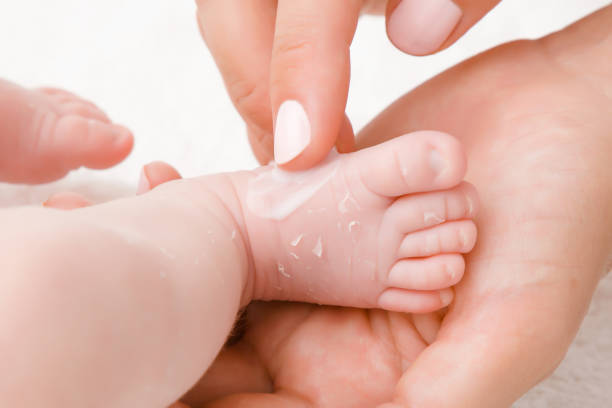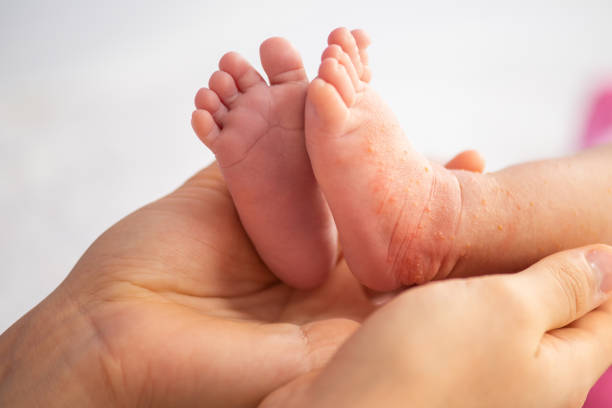Newborn Skin Peeling: Why? Treatment, and Care

Newborn skin peeling or flaky skin does not mean infection, it is a very common and natural happening shortly after a baby is born. It happens because their delicate skin, which was protected by the amniotic fluid in the womb, is now exposed to the dry outside environment. This transition from a moist to a dry environment leads to skin dryness and peeling.
Newborns have sensitive skin, and being aware of the causes of skin peeling can aid in the early detection of potential issues and timely intervention.
Table of Contents
What causes skin peeling in newborns?

Newborns, so delicate and new, often experience skin peeling during their early days of life. But Why Do Newborns Experience Skin Peeling?
Let’s explore why newborns experience skin peeling:
Shedding of Vernix Caseosa
One significant contributor to skin peeling in newborns is the shedding of vernix caseosa. Vernix caseosa is a white, waxy substance that coats a baby’s skin while they’re in the womb. It serves as protection in the amniotic fluid but starts to naturally peel away shortly after birth. This shedding process can leave the baby’s skin appearing flaky and peeling.
Hormonal Influence
Hormonal changes play a pivotal role in a newborn’s skin condition. During the final stages of pregnancy, maternal hormones pass through the placenta to the baby. After birth, these hormone levels drop, which can lead to skin dryness and peeling as the baby’s skin adjusts to this new environment.
Dry and Sensitive Skin
Newborns are born with exceptionally sensitive and delicate skin. Their skin is thinner and more susceptible to dryness than adult skin. The rapid transition from the amniotic fluid to the outside world’s drier conditions can result in skin dryness and subsequent peeling.
Environmental Factors
Environmental factors also contribute to newborn skin peeling. The air outside the womb is significantly drier, causing the baby’s skin to lose moisture more quickly. Additionally, factors like room temperature and humidity levels can affect skin health.
Read More: Bronchitis: Causes, Symptoms, Diagnoses & Natural Cure
Infections that Cause Newborn Skin Peeling
Newborn skin peeling can sometimes be associated with infections. While not all cases of skin peeling are due to infections, some infectious conditions can lead to skin issues in newborns. Here are a few infections that can cause skin problems in newborns:
- Candidiasis (Yeast Infection): Candidiasis can affect a baby’s skin, causing redness, rash, and peeling. It commonly appears in moist areas, such as the diaper area or the folds of the skin.
- Staphylococcal and Streptococcal Infections: These bacterial infections can result in skin irritation, redness, and peeling. They may cause conditions like impetigo, a contagious skin infection common in children.
- Herpes Simplex Virus (HSV): HSV infection in newborns can lead to a condition known as neonatal herpes. This viral infection can cause skin rashes, blisters, and peeling, along with more severe health complications.
- Group B Streptococcus (GBS): GBS can sometimes cause skin infections in newborns, leading to peeling and other skin-related symptoms.
Related: Postpartum Rage: Causes, Symptoms & How to Deal with Mom Rage.
Vitamin Deficiency that Causes Newborn Peeling Skin
Newborns can also experience skin issues due to vitamin deficiencies, particularly vitamin K and vitamin D
- Vitamin K Deficiency: Newborns are often born with low levels of vitamin K, which plays a crucial role in blood clotting. Vitamin K deficiency can lead to a condition called “hemorrhagic disease of the newborn“, which can cause bleeding, including bleeding under the skin, resulting in skin issues such as bruising and discolouration.
- Vitamin D Deficiency: Vitamin D is essential for skin health and overall development. A deficiency in vitamin D can lead to skin problems in newborns, including dryness, peeling, and rashes. It can also affect bone development and overall growth.
When Does Newborn Skin Peeling Typically Occur?

Newborn skin undergoes a fascinating journey of adaptation during the early days of life. To comprehend when skin peeling typically occurs, let’s take a closer look at the timeline of newborn skin development:
- Birth to First Few Days: In the immediate aftermath of birth, a newborn’s skin may still bear traces of vernix caseosa, the protective substance they’re covered in while in the womb. This vernix often begins to naturally slough off during the first few days, revealing the baby’s underlying skin.
- Within the First Week: Some newborns may experience mild skin peeling within the initial days of life as they shed vernix caseosa remnants. As the baby adjusts to the drier environment outside the womb, their skin may become dry and may start to peel, especially in areas like the hands, feet, and ankles.
- Around 2 to 3 Weeks: The majority of skin peeling in newborns typically occurs around the second to third week of life. This is when the baby’s skin adapts to the outside environment, which is often drier than the amniotic fluid in the womb.
Read Also: Thinspo: Effects on Body, Mental and Physical Health.
How long does newborn skin peeling last?
How long does peeling skin take to clear?
The duration of newborn skin peeling can vary from baby to baby, but generally, it is a temporary and self-resolving condition that fixes itself. Here’s a rough estimate of how long newborn skin peeling typically lasts and when it may clear up:
- Mild Peeling: For many newborns, especially those with mild skin peeling, it may only last for a few days to a couple of weeks. This is often the case when the peeling is a result of the baby’s skin adjusting to the dry outside environment after birth.
- Moderate Peeling: Babies with more moderate peeling may continue to experience it for up to a few weeks. During this time, the peeling may be more noticeable on areas like the hands, feet, and ankles.
- Severe Peeling: In rare cases, some babies may have more severe skin peeling that persists for several weeks. This can be influenced by factors such as genetics, skin type, and the baby’s overall health.
For You: Seronegative Arthritis: Symptoms, Diagnosis, and Treatment.
Is it normal for a 1-week-old baby’s skin to peel?
Yes, it is entirely normal for a 1-week-old baby’s skin to peel. In fact, it’s quite common. The peeling of a newborn’s skin is often a natural part of their early development as they adjust to the drier environment outside the womb.
The peeling may be most noticeable on areas like the hands, feet, and ankles, but it can occur elsewhere on the body as well. This peeling is usually temporary and typically not a cause for concern.
Does skin peeling mean growth?
Skin peeling in newborns is not directly related to growth. Instead, it is primarily a result of the baby’s skin adjusting to the new environment outside the womb. As the baby’s skin adapts to the drier air and changes in temperature, it may become dry and start to peel. This process is part of the normal transition from the protective amniotic fluid in the womb to the outside world. While skin peeling doesn’t signify growth, it does indicate that the baby’s skin is adapting to its surroundings.
When should I be worried about newborn peeling skin?
Newborn skin peeling is usually a benign and temporary condition. However, there are situations where you should consult a healthcare provider or paediatrician if you are concerned about your baby’s skin peeling:
- Excessive or Severe Peeling: If your baby’s skin peeling is extremely severe, covers a large portion of their body, or if seems uncomfortable or in pain, it’s a good idea to seek medical advice. This could be a sign of an underlying issue.
- Blisters or Sores: If you notice any blisters, sores, or signs of infection along with skin peeling, consult a healthcare provider promptly.
- Skin Changes in Specific Areas: If the skin peeling is localized to specific areas and accompanied by other symptoms like redness, swelling, or unusual discolouration, it’s important to seek medical attention.
- Failure to Improve: If your baby’s skin peeling does not improve or worsens over time, it’s advisable to consult a healthcare provider for an evaluation.
How do you treat peeling skin on newborns?

Although the skin of a newborn will heal after peeling, these are tips for treating peeling skin on Newborns:
- Give your newborn gentle baths using lukewarm water. Avoid using hot water, harsh soaps, or excessive scrubbing, as these can further dry out the skin. Use a mild, fragrance-free baby soap and limit baths to a few times a week to prevent over-drying.
- After bathing, pat your baby’s skin dry with a soft towel and apply a hypoallergenic, fragrance-free baby moisturizer. Look for products recommended by paediatricians. Applying the moisturizer when the skin is slightly damp helps lock in moisture.
- Avoid using adult skincare products or lotions on your newborn’s skin, as they may contain ingredients that are too harsh for delicate baby skin.
- Ensure your baby is adequately hydrated by providing frequent feedings, whether through breastfeeding or formula feeding.
- If you live in a dry climate or during the winter months when indoor air tends to be drier, consider using a humidifier in your baby’s room.
- Dress your baby in soft, breathable fabrics like cotton to minimize skin irritation. Avoid rough or scratchy materials.
- Keep your newborn out of direct sunlight and dress them in light, protective clothing if they need to be outside. Babies have sensitive skin and are susceptible to sunburn.
Does breast milk help dry skin?
Some parents have reported using breast milk to help with their baby’s dry skin, and there is anecdotal evidence suggesting that it can be beneficial for certain skin conditions. Breast milk contains natural moisturizing and anti-inflammatory properties, which soothe dry or irritated skin.
However, it’s essential to remember that while breast milk may offer some relief, it is not a substitute for proper skincare products and practices. If your baby’s skin is persistently dry or has other concerning symptoms, consult with your paediatrician for a professional evaluation and guidance on appropriate treatments and care.
Vaseline (petroleum jelly) can be a suitable option for moisturizing newborn peeling skin, but before applying Vaseline or any other skincare product to your baby’s skin, it’s advisable to perform a patch test. Apply a small amount of the product to a small area of your baby’s skin and monitor for any adverse reactions, such as redness or irritation. If no adverse reactions occur, you can use the product more widely.




One Comment